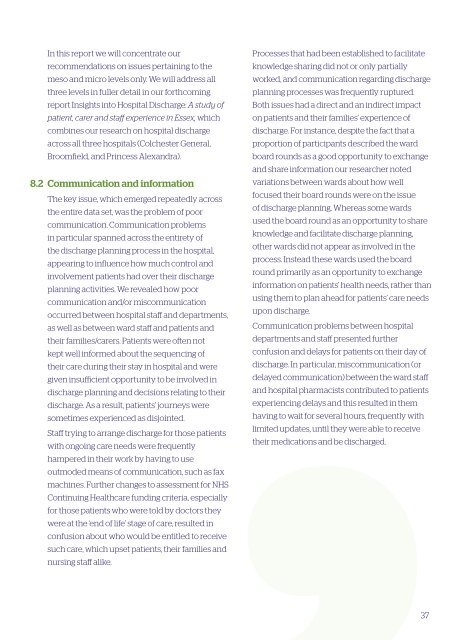Hospital Discharge
3Jzx309Yruj
3Jzx309Yruj
You also want an ePaper? Increase the reach of your titles
YUMPU automatically turns print PDFs into web optimized ePapers that Google loves.
8.2<br />
In this report we will concentrate our<br />
recommendations on issues pertaining to the<br />
meso and micro levels only. We will address all<br />
three levels in fuller detail in our forthcoming<br />
report Insights into <strong>Hospital</strong> <strong>Discharge</strong>: A study of<br />
patient, carer and staff experience in Essex, which<br />
combines our research on hospital discharge<br />
across all three hospitals (Colchester General,<br />
Broomfield, and Princess Alexandra).<br />
Communication and information<br />
The key issue, which emerged repeatedly across<br />
the entire data set, was the problem of poor<br />
communication. Communication problems<br />
in particular spanned across the entirety of<br />
the discharge planning process in the hospital,<br />
appearing to influence how much control and<br />
involvement patients had over their discharge<br />
planning activities. We revealed how poor<br />
communication and/or miscommunication<br />
occurred between hospital staff and departments,<br />
as well as between ward staff and patients and<br />
their families/carers. Patients were often not<br />
kept well informed about the sequencing of<br />
their care during their stay in hospital and were<br />
given insufficient opportunity to be involved in<br />
discharge planning and decisions relating to their<br />
discharge. As a result, patients’ journeys were<br />
sometimes experienced as disjointed.<br />
Staff trying to arrange discharge for those patients<br />
with ongoing care needs were frequently<br />
hampered in their work by having to use<br />
outmoded means of communication, such as fax<br />
machines. Further changes to assessment for NHS<br />
Continuing Healthcare funding criteria, especially<br />
for those patients who were told by doctors they<br />
were at the ‘end of life’ stage of care, resulted in<br />
confusion about who would be entitled to receive<br />
such care, which upset patients, their families and<br />
nursing staff alike.<br />
Processes that had been established to facilitate<br />
knowledge sharing did not or only partially<br />
worked, and communication regarding discharge<br />
planning processes was frequently ruptured.<br />
Both issues had a direct and an indirect impact<br />
on patients and their families’ experience of<br />
discharge. For instance, despite the fact that a<br />
proportion of participants described the ward<br />
board rounds as a good opportunity to exchange<br />
and share information our researcher noted<br />
variations between wards about how well<br />
focused their board rounds were on the issue<br />
of discharge planning. Whereas some wards<br />
used the board round as an opportunity to share<br />
knowledge and facilitate discharge planning,<br />
other wards did not appear as involved in the<br />
process. Instead these wards used the board<br />
round primarily as an opportunity to exchange<br />
information on patients’ health needs, rather than<br />
using them to plan ahead for patients’ care needs<br />
upon discharge.<br />
Communication problems between hospital<br />
departments and staff presented further<br />
confusion and delays for patients on their day of<br />
discharge. In particular, miscommunication (or<br />
delayed communication) between the ward staff<br />
and hospital pharmacists contributed to patients<br />
experiencing delays and this resulted in them<br />
having to wait for several hours, frequently with<br />
limited updates, until they were able to receive<br />
their medications and be discharged.<br />
37


